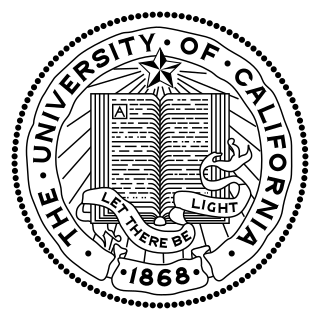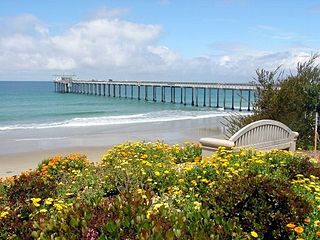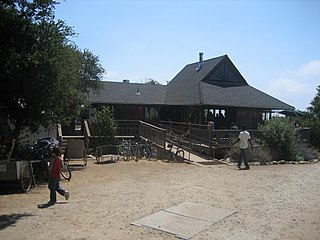
The University of California (UC) is a public land-grant research university system in the U.S. state of California. Headquartered in Oakland, the system is composed of its ten campuses at Berkeley, Davis, Irvine, Los Angeles, Merced, Riverside, San Diego, San Francisco, Santa Barbara, and Santa Cruz, along with numerous research centers and academic centers abroad. The system is the state's land-grant university.

The University of California, Santa Cruz is a public land-grant research university in Santa Cruz, California. It is one of the ten campuses in the University of California system. Located on Monterey Bay, on the edge of the coastal community of Santa Cruz, the main campus lies on 2,001 acres (810 ha) of rolling, forested hills overlooking the Pacific Ocean. As of Fall 2023, its ten residential colleges enroll some 17,812 undergraduate and 1,952 graduate students. Satellite facilities in other Santa Cruz locations include the Coastal Science Campus and the Westside Research Park and the Silicon Valley Center in Santa Clara, along with administrative control of the Lick Observatory near San Jose in the Diablo Range and the Keck Observatory near the summit of Mauna Kea in Hawaii.

The Scripps Institution of Oceanography (SIO) is the center for oceanography and Earth science at the University of California, San Diego. Its main campus is located in La Jolla, with additional facilities in Point Loma.
The University of California, Davis, School of Veterinary Medicine is the largest veterinary school in the United States. Established in 1948, the school is the primary health resource for California's animal populations. In 2020, the school was again ranked first in the United States by U.S. News & World Report and in 2022, ranked second in the world by QS World University Rankings. The school is located in the southwest corner of the main campus of the University of California, Davis. The current dean of veterinary medicine is Dr. Mark Stetter.
The Baskin School of Engineering, known simply as Baskin Engineering, is the school of engineering at the University of California, Santa Cruz. It consists of six departments: Applied Mathematics, Biomolecular Engineering, Computational Media, Computer Science and Engineering, Electrical and Computer Engineering, and Statistics.

The North Carolina Museum of Natural Sciences (NCMNS) is a natural history museum in Raleigh, North Carolina. The museum is the oldest in the state, and the largest natural history museum in the Southeastern United States.

Cape D'Aguilar Marine Reserve is the only Marine Reserve in Hong Kong. It is located at the far south-east corner of Hong Kong Island and covers an area of just 20 hectares, mainly between Kau Pei Chau and the rocky coastline. It was designated in July 1996 under the Marine Parks Ordinance to protect the rocky shores and the subtidal habitats in the area.
The UCSC Silicon Valley Initiatives are a series of educational and research activities which together increase the presence of the University of California in Silicon Valley. To that end, UC Santa Cruz has set up a 90,000 square-foot satellite campus called the University of Santa Cruz Silicon Valley Campus (SVC), currently located on Bowers street in Santa Clara, California, where it has been since April 2016 The Initiatives, still in the early stages of their development, have had ambitious hopes attached to them by UCSC, among them the possibility of a home for the University's long-planned graduate school of management and the Bio|Info|Nano R&D Institute. It currently houses professional the SVLink incubator-accelerator program, programs and a distance education site for the UCSC Baskin School of Engineering, the UCSC Silicon Valley Extension, the Office of Industry Alliances and Technology Commercialization leadership, and the University of California's online learning program, UC Scout.
The 3,848 acres (6.013 sq mi) Landels-Hill Big Creek Reserve located in the southern region of Big Sur, California is owned by the University of California Natural Reserve System. It is located off State Route 1 in 50 miles (80 km) south of Monterey and adjacent to the Big Creek State Marine Reserve and Big Creek State Marine Conservation Area. It is open only for approved research or educational purposes.

Wilder Ranch State Park is a California State Park on the Pacific Ocean coast north of Santa Cruz, California. The park was formerly a dairy ranch, and many of the ranch buildings have been restored for use as a museum. There are no campgrounds; a day-use parking lot provides access to the museum. Dogs are prohibited on the trails, but many trails allow bikes and/or horses. The long trails and ocean views make the area a favorite of hikers, equestrians and mountain bikers. Public beaches continue to the north in Coast Dairies State Park.

The California Institute for Quantitative Biosciences (QB3) is a nonprofit research and technology commercialization institute affiliated with three University of California campuses in the San Francisco Bay Area: Berkeley, San Francisco, and Santa Cruz. QB3's domain is the quantitative biosciences: areas of biology in which advances are chiefly made by scientists applying techniques from physics, chemistry, engineering, and computer science.

The UC Santa CruzCenter for Agroecology is a research, education, and public service organization within the Division of Social Sciences at the University of California, Santa Cruz.

Natural Bridges State Marine Reserve (SMR) is a marine protected area located at the northern edge of Santa Cruz, California, approximately 75 miles (121 km) south of San Francisco. The SMR covers 0.58 square miles (1.5 km2). The SMR protects all marine life within its boundaries. Fishing or other removal of any living marine resource is prohibited.
Tagging of Pacific Predators (TOPP) began in 2000 as one of many projects formed by Census of Marine Life, an organization whose goal is to help understand and explain the diversity and abundances of the ocean in the past, present, and future. After they were formed, TOPP began by building a coalition of researchers from all over the world to find and study predators of the Pacific Ocean. Since then, they have satellite-tagged 22 different species and more than 2,000 animals. These animals include elephant seals, great white sharks, leatherback turtles, squid, albatrosses, and more.
Jerry Earl Nelson was an American astronomer known for his pioneering work designing segmented mirror telescopes, which led to him sharing the 2010 Kavli Prize for Astrophysics.
The University of California High-Performance AstroComputing Center (UC-HiPACC) based at the University of California at Santa Cruz (UCSC) is a consortium of nine University of California campuses and three Department of Energy laboratories. The consortium's goal is to support and facilitate original research and education in computational astrophysics and to engage in public outreach and education.

Younger Lagoon Reserve is a 72-acre (28-hectare) University of California Natural Reserve System reserve on the northern shore of Monterey Bay in Santa Cruz County, California. The site is owned by the University of California and managed for teaching and research. It is adjacent to Long Marine Laboratory.
Adina Paytan is a research professor at the Institute of Marine Sciences at the University of California, Santa Cruz. known for research into biogeochemical cycling in the present and the past. She has over 270 scientific publications in journals such as Science, Nature, Proceedings of the National Academy of Sciences, and Geophysical Research Letters.
The UC Santa Cruz Genomics Institute is a public research institution based in the Jack Baskin School of Engineering at the University of California, Santa Cruz. The Genomics Institute's scientists and engineers work on a variety of projects related to genome sequencing, computational biology, large data analytics, and data sharing. The institute also maintains a number of software tools used by researchers worldwide, including the UCSC Genome Browser, Dockstore, and the Xena Browser.














